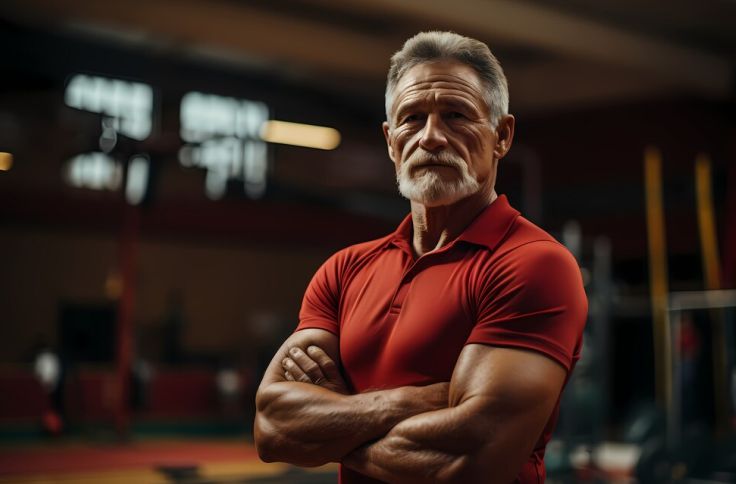Last updated on November 25th, 2025 at 03:46 pm
Fitness for older men over 50 is crucial for maintaining strength, vitality, and mental clarity. Discover how regular exercise can boost health and help you live an active, fulfilling life after 50.
My dad never engaged in routine exercises, not because he didn’t want to, but because his constant farming and gardening kept him physically active.
I used to call him the mechanical man, always engaged in physical tasks, with no need for machines or automation, even when clearing the grass around the house.
As men advance in age, particularly after turning 50, maintaining fitness becomes more important than ever.
Regular physical activity plays a chief role in promoting both physical and mental health, enhancing cardiovascular function, building muscle strength, and improving flexibility.
Despite common myths surrounding aging, older men can still engage in various fitness activities, from strength training to yoga, tailored to individual needs.
This guide will empower men over 50 to embrace fitness for a long, healthy, and vibrant life. New to men’s fitness? Start here.
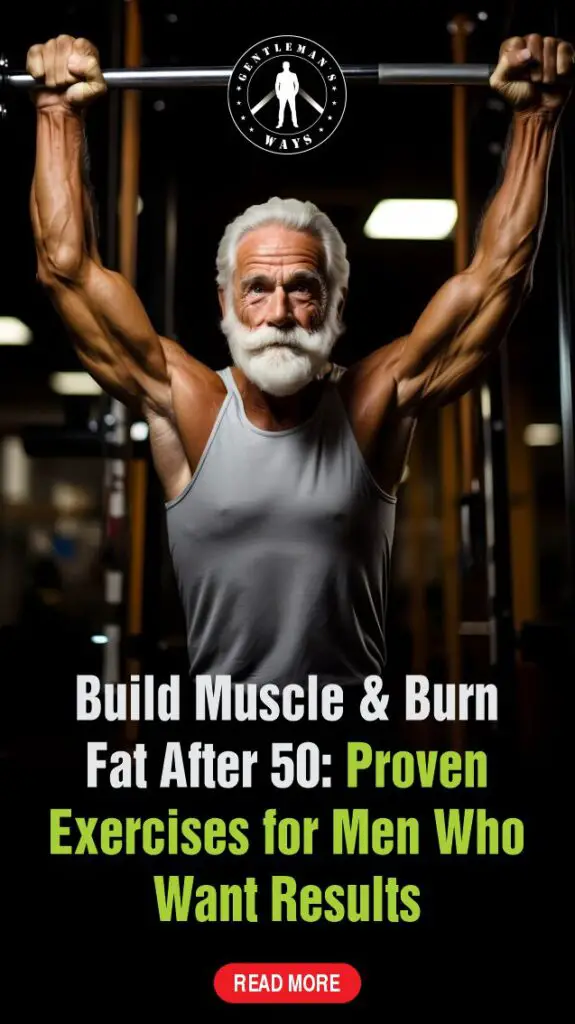
Table of Contents
- Benefits of Fitness for Older Men
- Considerations for Older Men Starting Fitness
- Types of Workouts and Exercises for Men Over 50
- Creating an Effective Fitness Routine for Older Men
- Nutrition and Hydration for Fitness for Men Over 50
- Staying Motivated and Consistent with Fitness for Senior Men
- Overcoming Common Fitness Challenges for Senior Men
- How My Dad Stayed Physically Active into His 80s
- Stay Fit at Home: Top Fitness Equipment for Older Gentlemen
- Frequently Asked Questions about Fitness for Older Men
- Conclusion
Benefits of Fitness for Older Men
Engaging in regular physical activity offers several health benefits that can improve your quality of life as you age.
Fitness is not just about staying active; it’s about feeling strong, energized, and capable of handling daily tasks with ease.
Here’s how getting fit can help as you get past 50 years as a man:
Better Heart Health
Yes, fitness for older men can guarantee good heart health. Exercise is key to maintaining a healthy heart.
Regular physical activity strengthens your heart, boosts blood circulation, and reduces your risk of heart disease, which tends to rise as you get older.
Simple activities like walking, cycling, or swimming can help improve your heart function, making it easier to stay active in your daily life.
Stronger Bones
Fitness for older men helps your bones. Your bones naturally lose density, which can lead to a higher risk of fractures or conditions like osteoporosis.
Weight-bearing exercises, such as strength training or resistance exercises, can help slow bone loss and increase bone density, keeping your skeleton strong and less prone to injury.
Preserving Muscle Mass
Losing muscle mass is common for men over 50, and this condition, called sarcopenia, can lead to weakness and frailty.
Regular strength training helps maintain your muscle mass, improving strength, balance, and overall mobility.
It also speeds up metabolism, helping you maintain a healthy body weight. These benefits allow you to stay active and more independent.
Improved Mental Well-being
Fitness does more than just improve physical health for men over 50. Exercise releases endorphins, natural chemicals in your brain that help reduce stress and boost your mood.
Staying active also helps improve memory and mental sharpness, which can be crucial as you advance in age.
By keeping your brain engaged, exercise supports both your body and mind.
Increased Energy
If you feel tired more often as you get past 50, regular exercise can help. It’s a great way to fight fatigue and boost energy levels, helping you feel more active throughout the day.
Staying fit can make a big difference in your vitality, allowing you to keep up with the demands of daily life.
Longer, Healthier Life
For older men, the benefits of staying active go beyond just feeling good now.
Research shows that regular exercise can add years to your life, allowing you to enjoy your later years with more energy and vitality.
By making fitness a part of your lifestyle, you’re setting yourself up for a more enjoyable and fulfilling future.
Recommended Posts
Men’s Health Guide to Living Your Best Life
Men’s Health Tips for Longevity
Health Screenings Men Over 60 Should Get
What You Should Know about Men’s Health After 50
Considerations for Older Men Starting Fitness
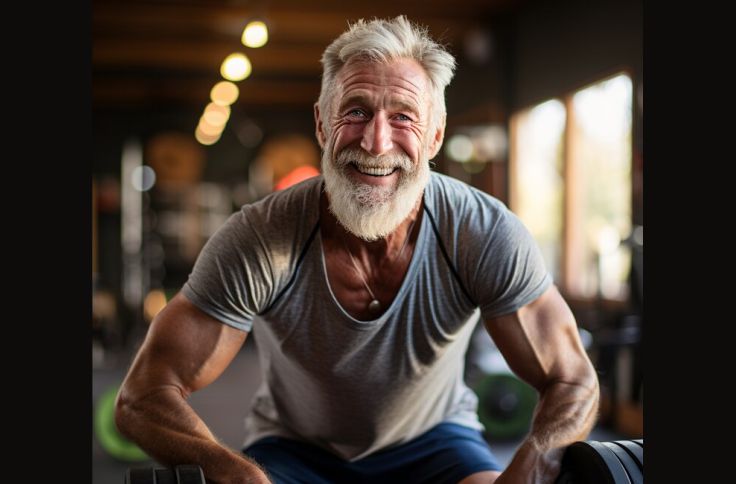
Starting a fitness routine for men over 50 comes with a few important things to keep in mind.
It’s more than getting active; it’s about doing it in a way that suits your body and health needs.
Here’s what to consider when beginning your fitness journey as an older man over 50:
Health Conditions and Fitness Plans
As you get older, certain health conditions may affect how you exercise. Issues like high blood pressure, diabetes, arthritis, or heart disease require adjustments to your workout routine.
It’s important to take these into account when planning your fitness journey.
Tailoring your exercise plan to your health needs will help you stay safe while still getting the benefits of regular activity.
Consulting with Your Doctor
Before diving into a fitness program, talk to your doctor. They can help you understand any existing health issues and recommend exercises that are safe for you.
A healthcare professional can also advise on what to do if any health concerns arise while working out.
This step ensures you’re taking the right approach to fitness based on your specific needs.
Modifying Your Workouts
As you start exercising, you may need to adjust the types of activities you do. Low-impact exercises are ideal for older men, especially when you’re just starting.
Walking, swimming, or cycling are great choices that protect your joints while building strength and improving flexibility.
Resistance training is also important for preserving muscle mass and bone strength, but be sure to modify intensity and duration to match your fitness level.
Setting Realistic Goals
Setting achievable fitness goals helps you stay motivated. Your goals should be clear, measurable, and something you can realistically reach in a specific time frame.
Tracking progress will give you a sense of accomplishment and keep you moving forward.
Just make sure to pace yourself, so you don’t push too hard too soon.
Rest and Recovery
Rest is just as important as exercise. As your body adapts to new physical activity, it needs time to recover.
This is especially true for older men, as recovery may take a bit longer. Make sure to include rest days in your routine to avoid injury and allow your muscles to heal.
Balancing exercise with proper recovery ensures that you can stick to a fitness plan in the long run.
By keeping these key factors in mind, you can create a fitness routine that supports your health, helps you avoid injuries, and boosts your well-being as you age.
Types of Workouts and Exercises for Men Over 50
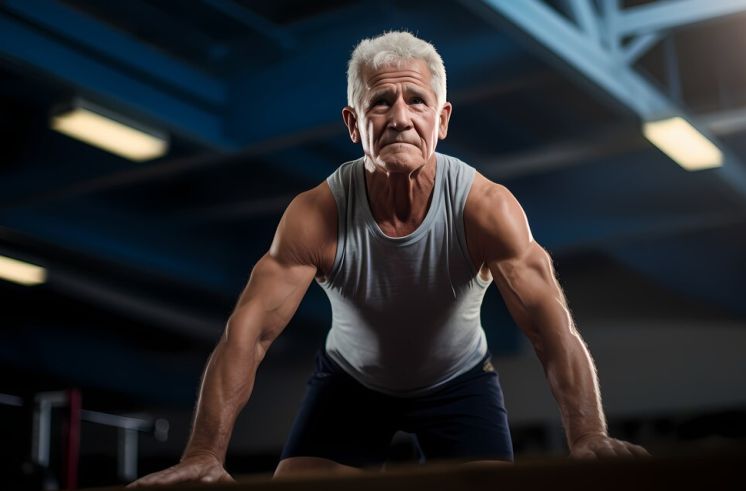
As men age, maintaining an active lifestyle becomes increasingly crucial for overall well-being.
A well-rounded exercise program can enhance strength, improve cardiovascular health, promote flexibility, and facilitate functional fitness.
Below, we explore several categories of exercise that cater to the unique needs of older men.
1. Strength Training
Strength training is one of the best ways you can stay strong, active, and independent as an older man.
As age advances, you naturally lose muscle mass, which can lead to weakness, slower metabolism, and reduced mobility.
Strength training helps prevent this by maintaining and rebuilding muscle. Start with bodyweight movements like squats, push-ups, and lunges, and gradually include resistance bands or light dumbbells.
Aim to train two to three times a week, allowing rest in between sessions. Strength training also improves bone density, supports healthy joints, and reduces the risk of falls.
It’s never too late to begin, and the benefits extend beyond the gym. Want a full routine? Read the post: Strength Training for Older Men
2. Cardiovascular Workouts
Cardiovascular exercise keeps your heart healthy, your weight in check, and your stamina up. For older men, it’s not about running marathons, it’s about consistent, moderate activity.
Walking, swimming, cycling, or even dancing are all effective ways to get your heart rate up.
Aim for at least 150 minutes of moderate-intensity cardio each week, broken into 30-minute sessions across five days.
Cardio helps improve circulation, lower blood pressure, and reduce the risk of chronic diseases like heart disease or diabetes.
It also boosts mood, brain health, and energy levels.
Choose activities you enjoy so you can stick with them long-term.
Learn more in our post: Cardio Workouts for Men Over 50
3. Flexibility and Balance Exercises
Maintaining good flexibility and balance becomes more important with age. These skills help prevent falls, reduce stiffness, and make everyday movements easier.
Yoga, tai chi, and Pilates are all excellent choices, focusing on stretching, balance, and body control.
These exercises build stability in the legs and core, improve posture, and help with coordination.
You don’t need to be flexible to begin, just start slow and stay consistent. A few minutes a day can protect your joints, support better mobility, and help you move without pain.
It’s also great for relieving stress and calming the mind. Discover more in our post: Flexibility and Balance Exercises for Older Men
4. Functional Fitness
Functional fitness focuses on exercises that mimic everyday movements, helping older men stay independent.
Activities such as step-ups, seated leg lifts, and twisted torso movements can enhance strength relevant to daily tasks like climbing stairs or carrying groceries.
Integrating functional exercises into a routine can significantly improve quality of life.
By embracing various forms of exercise, older men can cultivate a balanced fitness regimen that supports physical health and enhances mental well-being, fostering a more active and fulfilling lifestyle.
Get the full breakdown: Functional Fitness for Older Men
Creating an Effective Fitness Routine for Older Men
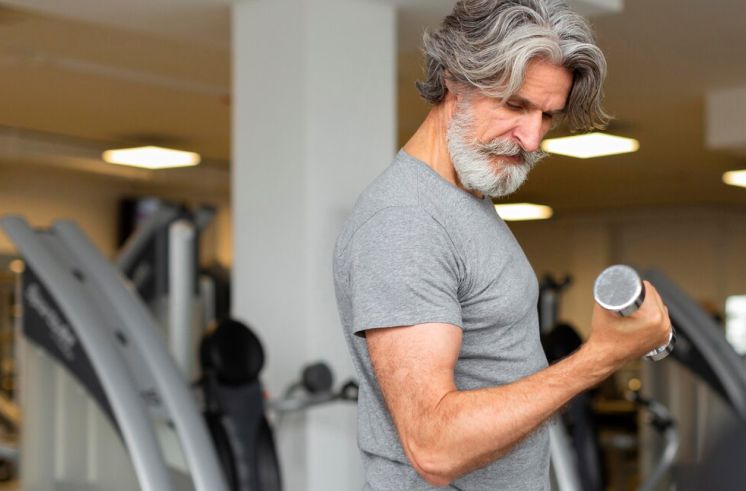
Building a steady fitness routine after 50 is one of the best things you can do for your health and energy.
It doesn’t have to be complicated. The key is finding what works for your body, your lifestyle, and your goals.
Here’s how to make your routine simple, safe, and something you’ll want to stick with.
Include Different Types of Exercise
Your routine should focus on these core areas:
- Strength: Keeps your muscles from shrinking as you age. Try bodyweight exercises, resistance bands, or light weights.
- Cardio: Supports heart health and keeps your stamina up. Go for brisk walks, bike rides, or water aerobics.
- Flexibility and Balance: Helps you move better and avoid falls. Add some light stretching or yoga a few times a week.
Aim for at least 150 minutes of activity each week. That can be 30 minutes a day for five days, or whatever suits your schedule. Just stay consistent.
Start with a Warm-Up and End with a Cooldown
Don’t skip this part. Warm up before each session to get your blood flowing and loosen your joints. March in place, roll your shoulders, or do some arm circles.
Cooldowns help you slow down and recover. Stretch the muscles you used, breathe deeply, and give your body a chance to wind down.
This helps prevent soreness and supports your next workout.
Keep It Interesting with Variety
Doing the same workout every day can get boring, and your body stops responding as well. Mix it up.
Try this weekly mix:
- Monday: Walk
- Tuesday: Resistance bands
- Wednesday: Rest or light stretching
- Thursday: Bike ride
- Friday: Yoga
- Saturday: Bodyweight strength moves
- Sunday: Rest
Change the order. Try new activities. Keep moving.
Pay Attention to Your Body
Your body will tell you when something feels off. If you’re overly tired, dizzy, or in pain, slow down or take a break.
Adjust the pace or duration of your workout. Rest days are not optional, they’re part of staying healthy and strong.
Build a Routine That Works for You
This is your fitness journey. Find a rhythm that fits your daily life and stick with it. The goal is to stay active without pushing too hard.
You’re not training for a race, you’re training for a longer, better life.
Fitness after 50 isn’t about doing more. It’s about doing what works. Stay steady, stay safe, and keep showing up.
Nutrition and Hydration for Fitness for Men Over 50

Once you hit 50, your body starts needing different fuel. What worked in your 30s won’t cut it now, especially if you’re trying to stay active and strong.
The right nutrition and enough water can make all the difference in how you feel and perform.
Get More Protein in Your Meals
Muscle loss is common as you age, but you can slow it down by eating more protein. If you’re working out regularly, your body needs it to recover and build strength.
Add these to your plate each day:
- Chicken or turkey
- Fish
- Eggs
- Greek yogurt or cottage cheese
- Lentils or beans
Aim to spread your protein across all meals instead of saving it for dinner.
Focus on Key Nutrients: Calcium and Vitamin D
Your bones lose strength with age. Calcium and vitamin D work together to keep them strong and lower the risk of fractures.
Add these to your routine:
- Dairy: milk, cheese, yogurt
- Leafy greens: spinach, kale, collards
- Fortified foods: cereals, plant-based milks
- Fatty fish: salmon, mackerel, sardines
- Sunshine: just 15 minutes on your skin helps boost vitamin D
If you don’t get enough through food, ask your doctor if you need a supplement.
Don’t Ignore Hydration
As you age, you might not feel thirsty even when your body needs water. Dehydration can mess with your energy, focus, and digestion.
Try this:
- Drink water with every meal
- Carry a water bottle and sip throughout the day
- Add a slice of lemon or cucumber for flavor
- Drink herbal teas or low-sugar drinks to mix it up
If your pee is dark yellow, you need more water.
Think About Joint and Muscle Support
Your joints take more wear and tear as you age. If you’re staying active, you might feel it in your knees or shoulders. Some men find support from:
- Omega-3s from fish oil
- Glucosamine
- Chondroitin
These may help with stiffness and soreness. Talk to your doctor before adding any supplement.
Keep It Simple and Consistent
You don’t need a strict diet plan. Just focus on whole foods, enough protein, and plenty of water.
When your body has what it needs, workouts feel better, recovery is faster, and daily movement becomes easier.
Make your food work for your body, not against it. Fuel it right, and you’ll feel the difference.
Recommended: 6 Foods Men Should Avoid at All Costs
Staying Motivated and Consistent with Fitness for Senior Men
You already know starting is hard, but staying consistent with fitness after 50 can feel even tougher.
Life shifts, energy levels dip, and sometimes the motivation just doesn’t show up. But if you build habits that work for you, staying on track becomes easier.
Set Real Goals You Can Stick With
Forget chasing your younger self. Your body is different now, and that’s okay. Focus on what you can do today.
Start here:
- Walk 30 minutes a day
- Do light strength training twice a week
- Improve flexibility with simple stretches
These small wins build up. When your goals are clear and realistic, it’s easier to show up again tomorrow.
Get People Around You Involved
You’re more likely to stick with your routine if you’re not doing it alone.
Try this:
- Invite a friend to join you for morning walks
- Sign up for a group class
- Join an online community for older men’s fitness
The encouragement and accountability help you stay focused, and you might even have fun while doing it.
Track Progress in Simple Ways
It’s easy to lose motivation if you don’t see where you’re going. A simple fitness app or journal helps.
You can track:
- How many steps did you take?
- What exercises did you?
- How do your energy levels feel?
- Weekly goals
When you look back and see how far you’ve come, it gives you a reason to keep going.
Celebrate Small Wins
Don’t wait for big milestones. Recognize the little things.
Reward yourself for:
- Not missing a workout this week
- Trying something new
- Feeling more flexible or stronger
Your reward doesn’t have to be big. A new playlist, a smoothie you enjoy, or even a quiet moment of appreciation can boost your drive.
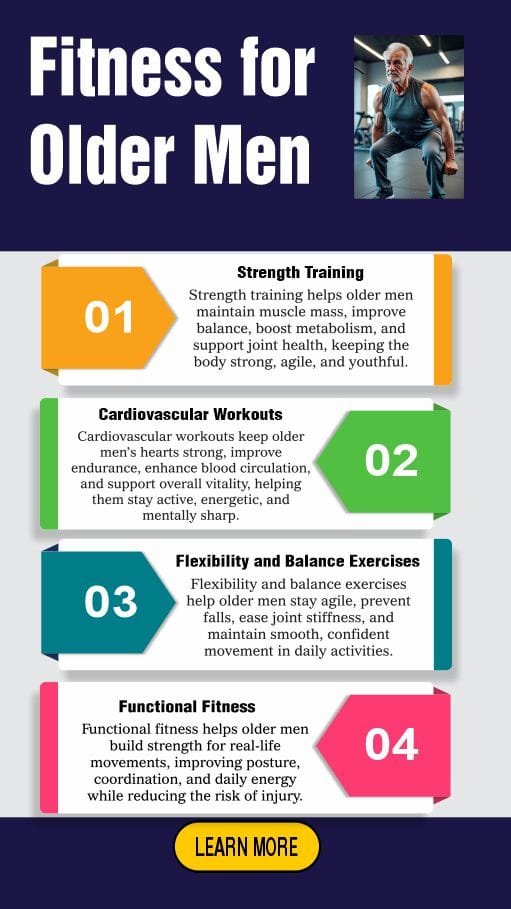
Overcoming Common Fitness Challenges for Senior Men
Sticking with fitness after 50 comes with a few roadblocks, but you can work around them.
You don’t need perfect conditions. You just need smart choices, good habits, and patience with yourself.
Avoiding Injuries
Your body isn’t bouncing back the way it used to. That’s normal. Less muscle and lower bone strength can make you more prone to injuries.
Here’s what you can do:
- Start every session with a proper warm-up
- Stretch daily to stay loose and mobile
- Work on your balance with simple moves like standing on one foot
- Focus on good form, not how much weight you’re lifting
- If you’re unsure, check in with a trainer who understands older bodies
A little care upfront keeps you active longer and avoids setbacks.
Beating Low Energy and Motivation
If you feel tired or not in the mood to move, you’re not alone. Hormones shift, sleep changes and some days are just tough. But you can recharge your drive.
Try this:
- Stick to regular sleep hours
- Eat real food that fuels your body
- Do workouts you enjoy, not ones that feel like punishment
- Go outside for a walk, it clears your head and gets your body moving
- Invite a buddy along or join a group. That little social boost can lift your mood
Some days will feel harder. Just don’t let one off day turn into a week.
Making Time When Life Feels Full
You’ve got a lot going on: work, family, maybe grandkids. But you don’t need an hour every day to stay active.
Here are a few ways to fit it in:
- 10-minute bodyweight workouts in the morning
- Walk during phone calls or after meals
- Do squats or stretches while watching TV
- Take the stairs
- Park farther from the store
It adds up. And when you plan your week, block out time for movement like you would for a meeting. It’s your health, you’re allowed to make it a priority.
How My Dad Stayed Physically Active into His 80s
As I mentioned earlier, my dad had a sedentary job, but that never stopped him from staying active.
Outside office hours, he turned to farming and gardening, not as a chore, but as his way of keeping fit.
He never joined a gym or followed fitness trends, yet he could carry heavy loads, work for hours under the sun, and still have energy left at the end of the day.
He rarely complained of fatigue. His body stayed strong because he didn’t wait until old age to start moving.
He began early, stayed consistent, and allowed physical activity to be part of his lifestyle, not something extra.
Even into his 80s, people were shocked at how capable he was. His story taught me that strength after 50 isn’t luck or genetics.
It’s built over time through steady habits and purposeful movement. If he could do it, so can you, one shovel, one stretch, one step at a time.
Stay Fit at Home: Top Fitness Equipment for Older Gentlemen
Maintaining strength and mobility is key for older gentlemen. These easy-to-use, low-impact fitness tools help you stay active, improve balance, and boost health, all from the comfort of home.
Arm & Leg Pedal Exerciser
This compact pedal exerciser is perfect for older men looking to improve circulation and muscle strength with low-impact workouts. Shop it here.
It features adjustable resistance, allowing users to customize the intensity for arms or legs. The sturdy design includes an anti-slip mat to keep it stable during use.
Ideal for home use, it supports gentle exercise routines, aiding rehabilitation, mobility, and cardiovascular health in a safe, convenient way.
GYMAX Pedal Exercise Bike
Designed specifically for seniors, the GYMAX pedal exercise bike offers a comfortable and effective way to stay active at home.
It features adjustable height and pedal length to suit different users.
The built-in LCD monitor tracks time, speed, and calories burned.
Soft massage rollers promote blood circulation, reducing fatigue.
Quiet and lightweight, it’s perfect for seated cardio and muscle toning with minimal joint stress. Buy GYMAX pedal exercise bike here.
Under-Desk Elliptical Machine
This electric under-desk elliptical provides a quiet, low-impact cardio workout while seated, making it ideal for older adults with limited mobility.
With 12 adjustable speed levels and a remote control, users can tailor their exercise intensity easily.
Its compact design fits under desks or tables, allowing workouts during work or leisure.
The smooth pedal motion helps improve leg strength, circulation, and joint flexibility safely and conveniently. Check it out in the marketplace.
GUGTTR Under-Desk Elliptical Machine
The GUGTTR under-desk elliptical is designed for seniors seeking low-impact exercise that fits into daily routines.
Fully assembled and portable, it’s easy to move and store. Offering 12 adjustable speeds, it accommodates different fitness levels and goals.
This elliptical helps strengthen leg muscles and improve cardiovascular health while minimizing joint stress.
Quiet operation means it won’t disturb others, making it ideal for home or office use.
Healthy Seniors Chair Exercise Program (Resistance Bands)
This resistance band set is tailored for older adults needing gentle strength training and physical therapy support.
It comes with two sturdy bands featuring comfortable handles and an easy-to-follow exercise guide.
The bands offer variable resistance, helping improve muscle tone, flexibility, and balance safely from a seated position.
Perfect for rehabilitation, mobility enhancement, or daily fitness, it promotes overall health without heavy equipment or high-impact stress. Check out the band in the markeplace.
WOLFMATE Smart Fitness Trainer
The WOLFMATE smart fitness trainer is a wall-mounted system designed to help older adults build strength and flexibility.
It integrates resistance bands with guided workouts delivered through an app or screen.
This compact device offers a full-body exercise solution that’s easy to use at home.
Ideal for enhancing mobility, balance, and muscle tone, it supports personalized fitness levels and promotes consistent exercise with smart tracking and coaching features.
Frequently Asked Questions about Fitness for Older Men
What is the best exercise for men over 50?
Walking, strength training, and low-impact workouts like swimming or yoga are great for maintaining strength and cardiovascular health after 50.
Can I build muscle after 50?
Yes. Regular strength training and increased protein intake help older men build and maintain muscle mass as they age.
How often should older men work out?
Aim for at least 150 minutes of moderate activity weekly, plus two days of strength training and rest days in between.
Is it safe to start exercising after 50?
Yes, with a doctor’s approval. Start slowly, choose low-impact activities, and build intensity gradually based on your fitness level.
Why is hydration important for fitness after 50?
Hydration supports energy, digestion, and focus. Older adults may not feel thirsty, so drink water consistently throughout the day.
Conclusion
Fitness for older men over 50 is not about chasing youth, it’s about staying strong, mobile, and independent for years to come.
You’ve seen how strength training, cardio, flexibility work, and proper nutrition come together to support your body and mind.
The key is to move with intention, stay consistent, and listen to your body like my dad did. You don’t need to do it all at once.
Small daily actions add up, and it’s never too late to start. Focus on what you can do and build from there.
Whether you’re walking, gardening, or hitting the gym, you’re investing in your long-term well-being. Fitness for older men over 50 isn’t a trend, it’s a lifestyle.
So start now. Understanding that every man’s fitness journey is unique can encourage a more positive mindset towards exercise.
Certainly, the key is to remain proactive and consistent while enjoying the process of becoming more active.
We encourage all older men to take the first step today, whether it be a short walk, a gentle yoga session, or a visit to the gym.
Health is a lifelong journey, and every effort counts toward achieving a more fulfilling lifestyle.
References
- Strength training helps older adults live longer
- Weightlifting and Aerobic Exercise Are Good for You
- Physical activity guideline for older adults
Pyo Merez is a men’s lifestyle enthusiast and writer about the gentleman’s place and impact on society. Raised by a distinguished gentleman dad, he offers unique insights into how the mind of a gentleman works and how societal norms shape gentlemen’s identity and vice versa.
Through his insightful articles, Pyo taps into the depths of gentleman culture to provide perspectives on etiquette and manners in modern society.

